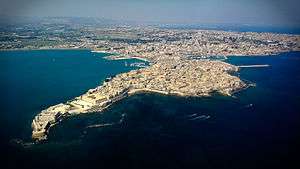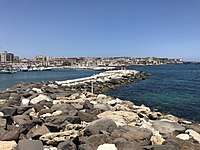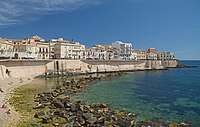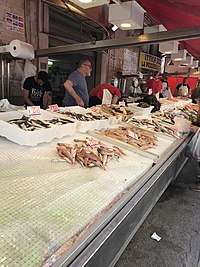Ortygia
Ortygia (/ɔːrˈtɪdʒiə/; Italian: Ortigia; Greek: Ὀρτυγία) is a small island which is the historical centre of the city of Syracuse, Sicily. The island, also known as the Città Vecchia (Old City), contains many historical landmarks. The name originates from the ancient Greek ortyx (ὄρτυξ), which means "Quail".

Overview
The Homeric Hymn to Delian Apollo has it that the goddess Leto stopped at Ortygia to give birth to Artemis,[1] the firstborn of her twins. Artemis then helped Leto across the sea to the island of Delos, where Leto gave birth to Apollo.[2] Other ancient sources state that the twins were born in the same place – which was either Delos or Ortygia[3] – but Ortygia, according to Strabo[4] was an old name of Delos. Further, there were perhaps a half-dozen other places called Ortygia, so that the identification is uncertain.[5]
It was also said that Asteria, the sister of Leto, metamorphosed into a quail (Ortyx), threw herself into the sea, and was metamorphosed into the island of Ortygia. Another myth suggested that it was Delos, rather than Ortygia.[6]
Ortygia was the mythological home of Arethusa, a chaste nymph who, while fleeing a river god, was transformed by Artemis into a spring, traversed underground and appeared here, thus providing water for the city. Arethusa and her pursuer, the river god Alpheus, came from Arcadia in Greece.
History
See main article: Syracuse, Sicily


Ortygia, being an island just off the coast, was easily transformed into a natural fortress with harbors and was big enough that it could hold a significant population in ancient times. Therefore, the history of Ortygia is synonymous with the early history of Syracuse.
Location

Ortygia is located at the eastern end of Syracuse and is separated from it by a narrow channel. Two bridges connect the island to mainland Sicily. The island is an extremely popular place for tourism, shopping, entertainment and also a residential area.
Subdistricts
Landmarks
- Cathedral of Syracuse
- Piazza del Duomo, Syracuse
- Piazza Archimede
- Fountain of Arethusa
See also
References
- Children of the Gods by Kenneth McLeish, pages 33 and 34.
- Homeric Hymn 3 to Delian Apollo
- theoi.com
- Book 14, 1.20,
- Hammond and Scullard (editors). The Oxford Classical Dictionary (Oxford: Clarendon Press, 1970), 760.
- ASTERIA on Theoi.com
External links
| Wikimedia Commons has media related to Ortigia. |
- Levinson Travel Guides
- Google Satellite Imagery
- Ortigia Island Website
- Ortigia Island Photos
- Official Fan Page